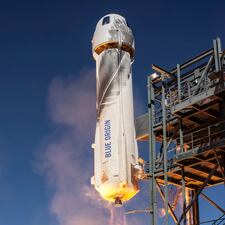WEST TEXAS, Fla. — Blue Origin, the rocket company founded by Amazon mogul Jeff Bezos, succesfully launched and landed its eighth test flight of the company’s New Shepard rocket Sunday.
The launch took place shortly after 1 p.m. at the company’s facility in West Texas.
The mission carried multiple instruments into orbit for multiple customers, the company said.
Below are some of the payload customers that are flying on Mission 8:
Suborbital Flight Experiment Monitor-2 (SFEM-2)
NASA Johnson Space Center (Houston, Texas)
NASA’s Suborbital Flight Experiment Monitor-2, or SFEM-2, was designed to characterize payload test environments in support of the NASA Flight Opportunities program and other payload initiatives. The sensor suite collects cabin environmental data (CO2, pressure, acceleration, acoustics) and also tests components for future flights on NASA’s Orion capsule.
Schmitt Space Communicator (SC-1x)
Solstar (Santa Fe, NM), developed with private funding
The Schmitt Space Communicator, named after Solstar advisor and Apollo 17 astronaut Harrison “Jack” Schmitt, is a technology demo to test the concept of providing commercial Wi-Fi access to in-space users. This flight test is being conducted with support from NASA’s Flight Opportunities Program.
Daphnia
University of Bayreuth with ZARM (The Center of Applied Space Technology and Microgravity at the University of Bremen) and funding from German space agency, DLR
The Daphnia experiment investigates the effects of microgravity on gene expression and the cytoskeleton of daphnia water fleas. This small invertebrate species is popular in design of future bioregenerative life support systems for human space exploration.
EQUIPAGE
Otto von Guericke University (Magdeburg, Germany) with ZARM (The Center of Applied Space Technology and Microgravity at the University of Bremen) and funding from German space agency, DLR
EQUIPAGE studies the motion of macroscopic rod shaped grains to validate physics models of these systems under microgravity conditions. Such “granular gases” allow researchers to study a unique state far from equilibrium and not possible in normal Earth environments.
EUPHORIE
University of Duisburg-Essen with ZARM (The Center of Applied Space Technology and Microgravity at the University of Bremen) and funding from German space agency, DLR
EUPHORIE uses a laser to examine the phenomenon of photophoresis, the interaction of light on solid particles suspended in a gas. As the laser heats one side of such particles, it warms nearby gas molecules and accelerates the particle towards its cooler side. This research has applications to the study of early solar system evolution and meteorite formation.

